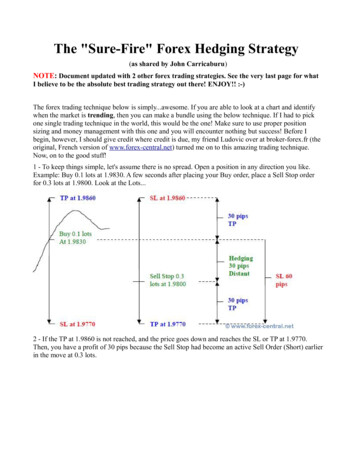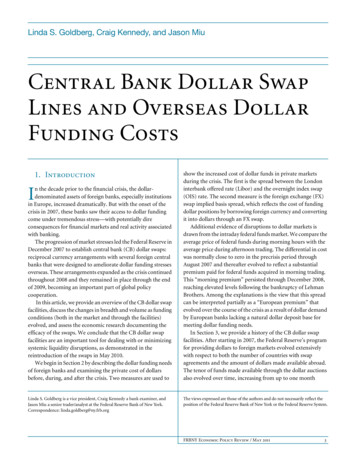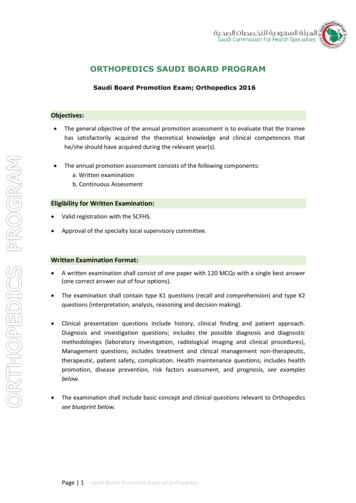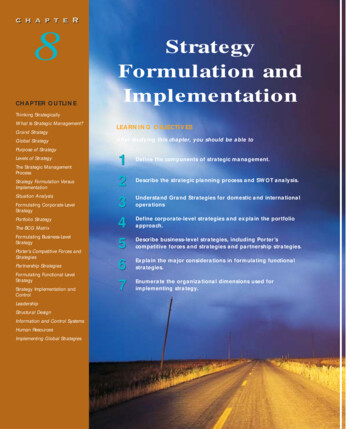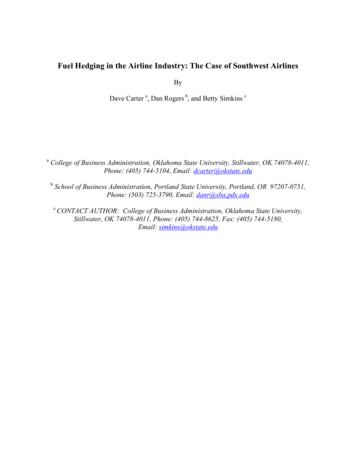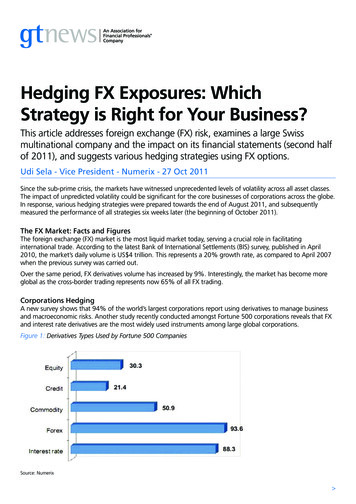
Transcription
Hedging FX Exposures: WhichStrategy is Right for Your Business?This article addresses foreign exchange (FX) risk, examines a large Swissmultinational company and the impact on its financial statements (second halfof 2011), and suggests various hedging strategies using FX options.Udi Sela - Vice President - Numerix - 27 Oct 2011Since the sub-prime crisis, the markets have witnessed unprecedented levels of volatility across all asset classes.The impact of unpredicted volatility could be significant for the core businesses of corporations across the globe.In response, various hedging strategies were prepared towards the end of August 2011, and subsequentlymeasured the performance of all strategies six weeks later (the beginning of October 2011).The FX Market: Facts and FiguresThe foreign exchange (FX) market is the most liquid market today, serving a crucial role in facilitatinginternational trade. According to the latest Bank of International Settlements (BIS) survey, published in April2010, the market’s daily volume is US 4 trillion. This represents a 20% growth rate, as compared to April 2007when the previous survey was carried out.Over the same period, FX derivatives volume has increased by 9%. Interestingly, the market has become moreglobal as the cross-border trading represents now 65% of all FX trading.Corporations HedgingA new survey shows that 94% of the world’s largest corporations report using derivatives to manage businessand macroeconomic risks. Another study recently conducted amongst Fortune 500 corporations reveals that FXand interest rate derivatives are the most widely used instruments among large global corporations.Figure 1: Derivatives Types Used by Fortune 500 CompaniesSource: Numerix
Interestingly, the usage of derivatives is almost evenly spread among the different tiers of the companies of theFortune 500, as the following Figure 2 illustrates. This may seem counterintuitive.Figure 2: Hedging Usage by Tier Among Fortune 500 FirmsSource: NumerixThe Swiss FrancThe recent turmoil in the markets has triggered a run to financial assets that market practitioners perceive asa ‘safe haven’ currency. Among these assets, one can find US and German government bonds (which tradedlast month at very low yields - 1.78% and 1.75% respectively), gold (which traded last month at US 1900 perounce), as well as other assets.Traditionally, the Swiss franc has been perceived as a ‘safe haven’ currency. The country’s economy is one of theworld’s most stable economies thanks to its policy of long-term monetary security and political stability.The Swiss economy is strong, characterised by low inflation and unemployment, as well as low national debt(38.3% in 2010) and unemployment (3.0% May 2011). As one might have expected, the Swiss franc didstrengthen over the course of the past three years, as Figure 3 illustrates.Figure 3: US Dollar/Swiss Franc Three Years Spot Rate ChartSource: Numerix
Case Study: NestleNestle is one of the world’s largest nutrition, health and wellness companies. It operates in almost all countriesin the world, and its annual sales in 2010 were almost CHF110bn.As a genuine global company, Nestle’s financial performance (1H11) was significantly impacted by thestrengthening of the Swiss franc. The overall impact on its various businesses was minus 13.8%, as Figures 4and 5 illustrate.Figure 4: Changes in Main Currencies and the Impact on Nestle’s Financial PerformanceSource: NumerixFigure 5: Impact of Strengthening Swiss Franc on Nestle’s Business LinesSource: NumerixSuggested Hedging StrategiesThis part of the article will suggest various hedging strategies that could be applied by Nestle (and perhaps arebeing used to a certain extent by the company). For simplicity reasons, let’s assume that on 22 August 2011 thefirm has one projected cash flow of US 100m expected in six months that it needs to convert to Swiss francs.The possibilities the firm faces are: Take no action and convert to Swiss francs once the funds are delivered. Enter a six months forward transaction: Spot rate: 0.7900 (Swiss francs per US dollar). Six months forward rate: 0.7860 (Swiss francs per US dollar).
Buy a vanilla option (put US dollar/call Swiss franc). Hedge the exposure by entering into a multi-leg strategy - there are several hedging strategies.Buying a Vanilla OptionBuying a six months vanilla option (put US dollar/call Swiss franc), on a notional amount of US 100m, would givethe firm the right to sell the US dollar amount and buy Swiss francs at the pre-agreed strike price. The premiumis determined by the strike price. The higher the strike price is, the higher the prepaid premium. Table 1 displaysvarious strike price and the cost of each respective option. In general, the option’s premium increases as: The strike price is higher (the premium for an option struck at 0.7960 is higher than the premium for anoption struck at 0.7860, for the same expiry date). In the case of call US dollar options, the premium reducesas the strike price increases. The option’s expiry date is longer (the premium for an option expiring in one year is higher than an optionexpiring in six months for the same strike price).Table 1: US Dollar Put/Swiss Franc Call Pricing Grid (Premium in Swiss Franc, Notional Amount US 100m)Source: NumerixEntering a ‘Forward Extra’This strategy is commonly-used by corporate treasurers. It is composed of buying one option and selling the other.The options are typically structured in a way that the overall cost for the corporate hedger is zero (the premium ofthe sold option offsets the premium of the bought option). The details of the strategy are as following: Buy a vanilla option: put US dollar/call Swiss franc strike 0.7800. Sell call US dollar, put Swiss franc SP07800 reverse knock in (RKI) with an activation trigger set at 0.8403.The trigger is ‘American’, implying that the option could be triggered anytime during the life of the option.However, if the market never trades at the trigger level (0.8403, in this example) or above, the option couldnot be exercised. Even amounts US 100m (each option). Same expiry date (six months).The payoff of the forward extra strategy, at expiry would be as follows: Fully protected if market trades on expiry date at 0.7800 or below (sell at 0.7800). Sell the US dollar amount at the prevailing market rate if the underlying asset (USD/CHF) didn’t trade at0.8403, since the inception of the trade. Sell at 0.7800 in case the market traded at 0.8403.The advantages of this strategy are: The worst case is known in advance (0.7800). Potential to sell up to 6.9% above the forward rate (best case 0.8403-0.7860). The strategy could be structured at zero initial cost.The disadvantages of this strategy are: Limited upside: in case the Swiss franc weakens above 0.8403, the hedger is locked into 0.7800 and missesthe unlimited upside potential. The worse-case scenario is inferior to the forward rate.
Entering a ‘Bonus Forward’This strategy is composed of three options. Two are bought by the hedger and one is sold. The premium that isreceived from the sold option is used to purchase the other two, in order to generate a zero cost strategy. Thestrategy is comprised of the following options (all non-vanilla options): Buy US dollar put, call Swiss franc strike price 0.7600 with a knock out trigger set at 0.8200. Buy US dollar put, call Swiss franc strike price 0.7890 with a knock in set at 0.8200. Sell US dollar call, Swiss franc put strike price 0.7890 with a knock in set at 0.8200. Even amounts US 100m per option. Same expiry date (six months).The payoff of the bonus forward strategy, at expiry, would be as following: The hedger is fully protected if market trades on expiry date at 0.7600 or below. If the spot rate never traded at 0.8200, the company would sell its US dollar amount at the prevailing marketrate (up to 0.8200). In case the US dollar/Swiss franc spot traded above 0.8200 the firm would sell its US dollars at 0.7890.The advantages of this strategy are: The worst case is known in advance (0.7600). In the best case, the firm could sell the US dollar receivables at 0.8199 (4.31% above the forward rate). The strategy could be structured at zero initial cost.The disadvantages of this strategy are: Limited upside: if the USD/CHF spot rate trades at 0.8200 or above, the firm would be locked to selling its USdollars at 0.7890 (still above the forward rate). Essentially, once 0.8200 level trades a synthetic forward deal isactivated (the two knock-in options). The worse-case scenario is inferior to the forward rate.Entering a Risk ReversalThis is yet another strategy frequently used by firms. It is also known as ‘collar’, ‘cylinder’, ‘fence’ or tunnel. It iscomposed of two vanilla options (one bought and one sold): Buy US dollar put, call Swiss franc at strike price 0.7600. Sell US dollar call, Swiss franc put struck at 0.8030. Even amounts US 100m per option. Same expiry date (six months).The payoff of the risk reversal strategy, at expiry, would be as following: The hedger is fully protected if spot rate trades on expiry date at 0.7600 or below. If the USD/CHF trades between 0.7600 and 0.8030, the hedger would sell at the prevailing market rate. In case the market trades above 0.8030 the US dollar amount would be sold at 0.8030.The advantages of this strategy are: The worst case is known in advance (0.7600). In the best case, the firm could sell the US dollar receivables at 0.8030 (2.16% above the forward rate) and upto this level the hedger participates in any potential upside. The strategy could be structured at zero initial cost.The disadvantages of this strategy are: Limited upside: if the USD/CHF spot rate trades at 0.8030 or above, the firm would be locked to selling its USdollars at 0.8030 (still above the forward rate). The worse-case scenario is inferior to the forward rate.
Entering a Participating ForwardThis strategy is composed of two vanilla options, one put US dollar and one call US dollar. Both options are struckat the same strike price and expire on the same day. However, the notional amounts are considered to be uneven.In our example, the strategy is composed of the following options (at zero cost): Buy US dollar put, Swiss franc call struck at 0.8060, notional amount US 100m. Sell US dollar call, Swiss franc put struck at 0.8060 notional amount US 200m. Same expiry date (six months).The payoff of the participating forward strategy, at expiry, would be as follows: The hedger is fully protected if spot rate trades on expiry date at 0.8060 or below and would sell US 100m tobuy Swiss francs. In case the market trades above 0.8060, the hedge would sell US 200m at 0.8060.The advantages of this strategy are: The hedging rate is known in advance (always fixed at 0.8060). The hedging rate in 200 points above the forward rate. The premium received from selling a call US dollar option with a doubled notional amount, is used to purchasean in the money US dollar put option, and thus generating a zero cost strategy. This strategy is used by clients that would sell additional amounts (beyond the original amount - US 100m inthis example) in case the market goes their way (receive more Swiss francs per US dollar).The disadvantages of this strategy are: Limited upside: if the USD/CHF spot rate trades above 0.8060 the firm would be obliged to selling its USdollars at 0.8060 (still above the forward rate). The hedger is forced into selling more US dollar than perhaps initially planned.Entering a Reset ForwardThis strategy is composed of eight options, including barrier options that generate a strip of four syntheticforward contracts (one active at a time). This strategy is structured at zero cost and offers participation infavourable market moves. Each time a certain barrier is met, one synthetic forward is deactivated (knocked out)and an additional contract is activated (knocked in).In this example, the strategy is composed of the following options: Buy US dollar put, Swiss franc call struck at 0.7725 knock-out 0.8200. Sell US dollar call, Swiss franc put struck at 0.7725 with knock-out at 0.8200. Buy US dollar put, Swiss franc call struck at 0.7800 with knock-in at 0.8200, knock-out at 0.8600. Sell US dollar call, Swiss franc put struck at 0.7800 with knock-in at 0.8200, knock-out at 0.8600. Buy US dollar put, Swiss franc call struck at 0.7900 with knock-in at 0.8600, knock-out at 0.9000. Sell US dollar call, Swiss franc put struck at 0.7900 with knock-in at 0.8600, knock-out at 0.9000. Buy US dollar put, Swiss franc call struck at 0.8000 with knock-in at 0.9000. Sell US dollar call, Swiss franc put struck at 0.8000 with knock-in 0.9000.The payoff of the reset forward strategy, at expiry, would be as following: The hedger is fully protected at 0.7725 or below, which is the worst case scenario level. If the spot rate trades above 0.8200 the hedging rate improves to 0.7800. If the spot rate trades higher, at 0.8600, the hedging rate improves again, to 0.7900. In case the spot rate trades at 0.9000 (or above), the final hedging rate would be 0.8000. All triggers could be activated anytime during the, life time of the option.The advantages of this strategy are:
The firm is fully hedged below 0.7725. The hedging rate improves in case the Swiss franc weakens up to 0.8000. Two levels, if triggered (0.7900 and 0.8000) offer a hedging rate above the forward rate (0.7860). Structured as a zero cost strategy.The disadvantages of this strategy are: Limited upside: the best case scenario is limited to 0.8000. The worst case scenario (0.7725) is below the forward rate 0.7860).Entering a ‘Flipper’This strategy is composed of four fade-in options with a knock-out trigger (all triggers are set at the same level).Upon inception, six monthly fixings are set and are compared to the fade-in level, as a result, a synthetic forwarddeal is generated (for 1/6 of the overall notional amount per fixing date). The fade-in level is set at one uniquespot rate, so only two outcomes are possible.The strategy is composed of the following options: Buy fade-in US dollar put, Swiss franc call option struck at 0.7800 fade-in level below 0.7800, with knock- outset at 0.6500. Sell fade-in US dollar call, Swiss franc put option struck at 0.7800 fade-in level below 0.7800 with knock- outset at 0.6500. Buy fade-in US dollar put, Swiss franc call option struck at 0.7975 fade-in level above 0.7800 with knock- outset at 0.6500. Sell fade-in US dollar call, Swiss franc put option struck at 0.7975 fade-in level above 0.7800 with knock- outset at 0.6500.The payoff of the reset forward strategy would be as follows: Once a month (until expiry date 22 February 2012), the daily rate of the USD/CHF spot rate is sampled. If it settles below 0.7800, you sell US 16,666,666.67 at 0.7800. If it settles above 0.7800, you sell US 16,666,666.67 at 0.7975. If the spot rate trades below 0.6500, the structure knocks-out and the buyer of structure would sell the USdollar amount at the prevailing market rate.The advantages of this strategy are: The firm is hedged below 0.7800 (worst case scenario), as long as the spot rate doesn’t trade below 0.6500during the six months post-inception (over 7.7% below the lowest level the USD/CHF spot rate has ever traded). The best case scenario is 0.7975 (1.46% above the forward rate). The strategy is structured at zero cost.The disadvantages of this strategy are: Limited upside: selling at 0.7975 would be the best case scenario. If the USD/CHF spot rate trades at 0.6500 or below the whole structure knock-out and the hedger isunprotected from further Swiss franc appreciation (the accumulated hedge is kept). The worst case scenario is inferior to the forward rate.ConclusionThis article revolves around a realistic example of hedging challenges treasurers typically face. We have suggestedvarious strategies that could solve this business problem. These strategies express different approaches to hedging,and as a result are structured differently. They are composed of vanilla and exotic strategies and are structured aszero cost. It is important to remember that one can set the hedging levels according to one’s view and that thesestrategies shouldn’t necessarily be structured at zero cost. The table below summarises the various strategies.
Table 2: Suggested Strategies Performance SummarySource: NumerixSince this article was initially written, the volatility in the market has increased and the Swiss National Bank hasannounced that it would buy any amount of euros and sell Swiss francs at the level of 1.2000 (Swiss francs pereuro). This has triggered a major shift in market’s sentiment and the Swiss franc has weakened since against theUS dollar and hovers currently at 0.9000 (Swiss francs per US dollar).We thought it would be interesting to display the changes in the market values of the suggested strategies as oftoday (mid-October 2011) assuming the market will trade at the same level at the expiry date.Table 3: One Month on SummarySource: NumerixUdi Sela, vice president at Numerix, has worked in the foreign exchange (FX) derivativesmarkets for 18 years. A senior derivatives trader and trading manager at Citibank andJPMorgan, he has developed expertise in derivatives spanning both vanilla and complex FXoptions. During the last seven years, Sela has led product development and pre-sales functionswithin a range of financial software vendors.Numerix is the award-winning, leading independent analytics institution providing cross-asset solutions forstructuring, pre-trade price discovery, trade capture, valuation and portfolio management of derivatives andstructured products. Numerix offers clients a highly flexible and fully transparent framework for the pricingand risk analysis of any type of over-the-counter (OTC) derivative financial instrument. From vanillas and‘semi-exotics’ to bespoke derivatives, structured products and variable annuities, Numerix allows users tocalculate prices and manage risk using any data set. Since its inception in 1996, over 700 clients and 50partners across more than 25 countries have come to rely on Numerix analytics for speed and accuracy invaluing and managing the most sophisticated financial instruments. With offices in New York, Chicago, SanFrancisco, Vancouver, London, Paris, Tokyo, Hong Kong, Beijing, Singapore, Seoul, Sydney, Mumbai andDubai, Numerix brings together unparalleled expertise across all asset classes and engineering disciplines.http://www.gtnews.com/article/8523.cfm
Case Study: Nestle Nestle is one of the world’s largest nutrition, health and wellness companies. It operates in almost all countries in the world, and its annual sales in 2010 were almost CHF110bn. As a genuine global company, Nestle’s financial performance (1H11) was signif



